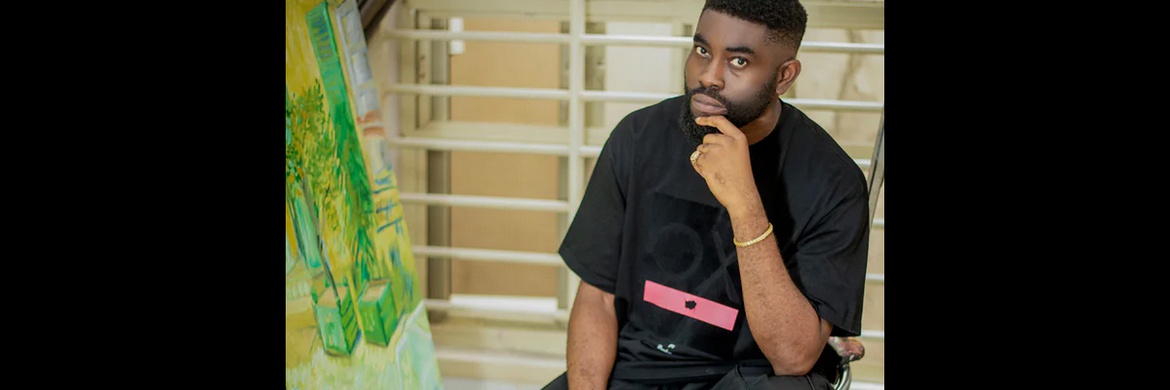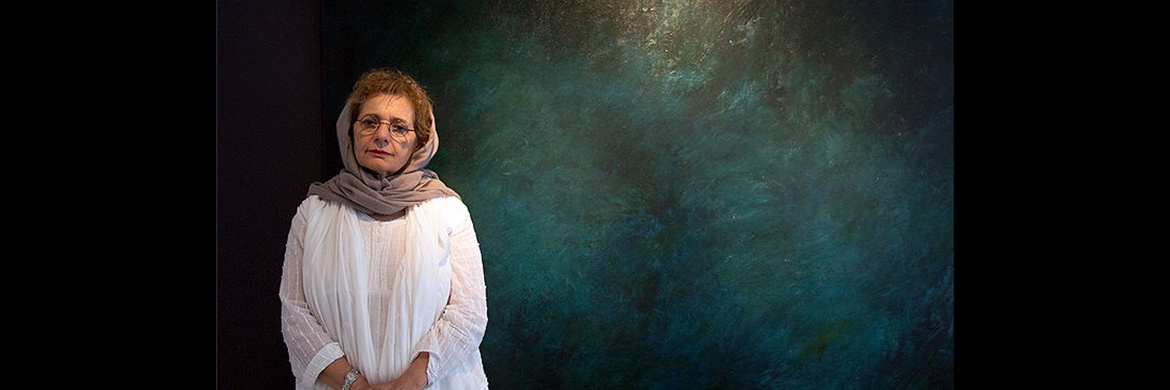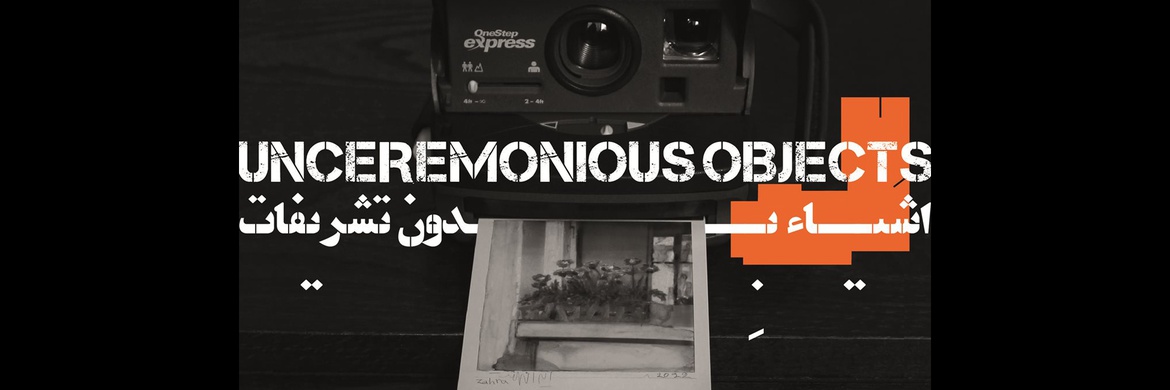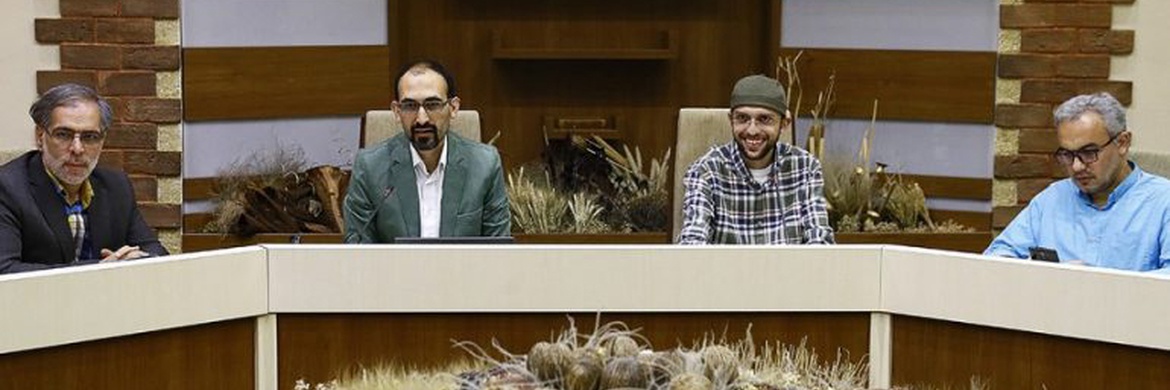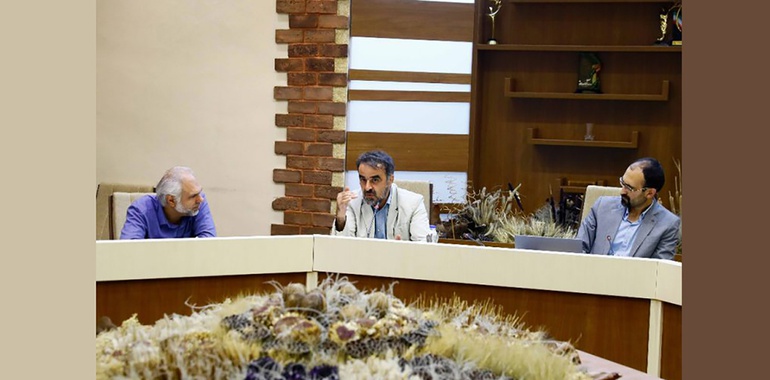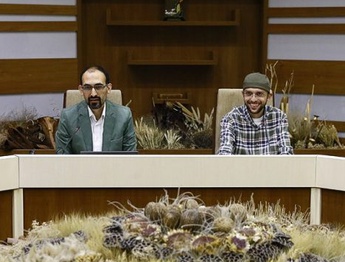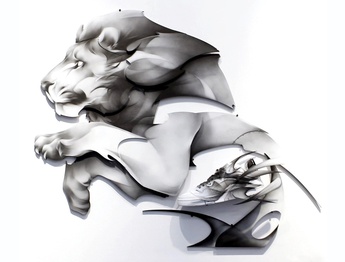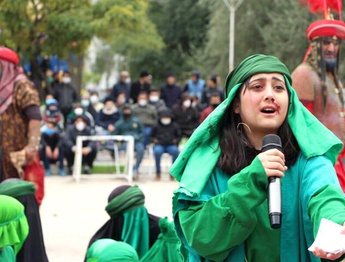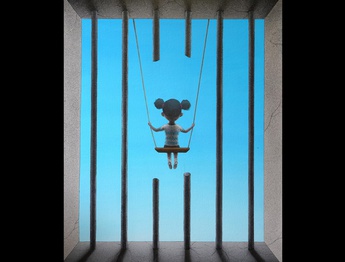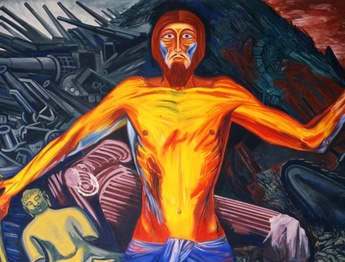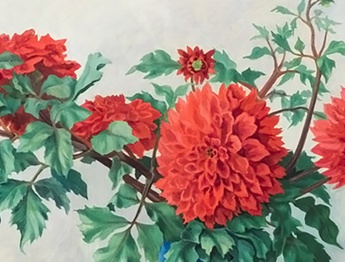According to the public relations report of the center of visual arts, according to the news site of the art field, Islamic culture and art research institute, on Monday, the third of Mordad this year, in the form of the 39th meeting of art and thought "Deedar" under the title of the meeting "Sweet rebellion in the streets" with the presence of Dr. Behnam Zangi, head of the Iranian Art Research Association, Alireza Shefah, a scholar and philosophy teacher, Amin Montazeri, a graffiti artist and street art researcher, and Mohammadreza Vahidzadeh, secretary of the meeting and art researcher, took a look at Mirza Hamid's graffiti collection.
Mohammad Reza Vahidzadeh, the secretary of the "Sweet Rebellion in the Streets" meeting and a researcher in the field of art of the 39th Contemporary Art and Thought Forum, started the meeting as follows: Mirza Hamid is a street artist and graffiti artist and is considered one of the serious street artists of our country these days.
He added: "Perhaps the question has arisen for our audience, is Mirza Hamid present at the "Sweet Rebellion in the Streets" meeting?" In response to this question, I must say that Mirza Hamid is an unknown artist and like many graffiti artists in the world, he prefers not to be known. In my opinion, we should also respect his wish and if an artist does not want to be recognized, we should respect his point of view.
The secretary of the "Sweet Rebellion in the Streets" meeting said: Today, it can be seen that some people like to be informed from behind the scenes, or if they have information from there, they pass on their information to others. This has caused artists like Mirza Hamid to stay away from the media, and this distance of artists from the media is perhaps the result of the conditions that people like me have created with carelessness, disrespecting the opinions of artists, and disrespect.
Vahidzadeh mentioned an interesting example and said: An artist like Banksy, who is considered the most popular artist in England according to recent polls, is still unknown. A lot of media and paparazzi would like to know his name, but it's amazing that people who know Banksy have helped to keep his name hidden and Banksy's identity unknown. Still no one can say with certainty who this artist is and I think this is an interesting thing.
He stated: Here I must say that Mirza Hamid did not like to be known, so he is not present at the "Sweet Rebellion in the Streets" meeting, but I know that he follows our program, so I congratulate him that an exhibition of his works was held in New York in recent days.
Amin Montazeri, a graffiti artist and street art researcher, said in the first part of the "Sweet Passion in the Streets" meeting about the history of graffiti art in the world and Iran: We have a debate as street art and graffiti, which we must separate from each other.
He added: We are now in the period of post-graffiti. We know graffiti as the dumb protest style of artists who wanted to show off in an era. Their main tool was spray.
This graffiti artist said: Today we know street art with more tools, which means that over time, tools have entered this field to help artists show the artistic dimension of their works.
Montazeri said: We should divide the work of street artists into different categories by knowing their tools.
He continued: The fact that I said that today we are in the post-graffiti period means that in this period the protest part of the work is more than the destructive part of the work and here artists care more about the economy of work and the sale of their works. Nowadays, we see street art, stroking and playing on the wall more often.
Mohammadreza Vahidzadeh, the secretary of the "Shuri Shirin Dar Streets" meeting, said: I have understood so far that graffiti art can be a part of street art, but not necessarily every street art is graffiti art.
Usually, our wall works do not have an ID
He went on to say: Dr. Behnam Zangi, the head of the Iranian Art Research Association, as someone who has been working in the field of research on various arts for many years, and addressed him, tell us a little about the international and Iranian coordinates of street art.
Dr. Behnam Zangi said: We usually use words to create templates for artistic trends, and then these templates limit us in defining and expanding those artistic trends. In the sense that when we say artistic graffiti, we are referring to a protest movement that was formed in line with the protest against apartheid and the classification of industrial society in Europe and America. Therefore, when we want to discuss graffiti art, we look deeply at art that is less than a century old. This is because graffiti art is considered a rooted art and drawing in its style goes back thousands of years.
He added: I came across an interesting work in one of the side streets of Kargar Street many years ago. Then I took a picture of it and we talked about it in the environmental graphite class to find out what the differences and similarities are with other works. I was hoping to be able to find the owner of the said work, but even though my work is researching urban and mural arts, I could not find a trace of him until I met and talked with you and got more information about that artist. The fact that I, as a researcher about urban works and mural painting, cannot find enough information about an artist is a sign of several inadequacies. The first failure comes back to me somehow because I don't seem to be so eager to search that when I see a good work, I see it in a big package, current and context or historical period, so that I can more easily criticize it and know its criteria, values and components.
The head of the Iranian Art Research Association stated: The second failure is related to the way the works are presented. Usually, our wall works do not have an identifier, and graffiti art is anonymous in its essence, other urban arts do not have this characteristic in their essence, and if an identifier is not considered for them, it is a sign of our shortness. Today, we see quality works of art in cities that we don't know which artists belong to them, and this is a big flaw in urban arts.
Dr. Zangi continued: The third failure is due to the perpetrators of the issue, i.e. critics, art experts and the media. To this day, there is no place where graffiti is discussed and I do not hear Banksy's name there. Thank God, despite the fact that his art is anti-capitalist, Banksy is gradually entering the capitalist society and the media did it. The media managed to turn Banksy into an obscure but globally recognized figure, but unfortunately, our media never does for various reasons.
He said: If the media worked with awareness of the importance of introducing urban artists to the world, maybe today we could witness that the work of artists like Mirza Hamid would be removed from the monopoly of the walls of Tehran and be seen on the walls of different cities of the world. In this way, an artistic movement becomes a dynamic artistic movement, otherwise our artistic movements will slowly fade away, not be recognized, not find a way to grow and be left to history.
The head of Iran's Art Research Association added: "Today, we see works and arts in museums that, if they were given the attention they should have at the time of their creation, they could have become permanent artistic trends as deconstructive movements based on our own components." I predict that this will also happen to the graffiti flow of our country.
Graffiti is a kind of southern urban art
Mohammadreza Vahidzadeh, the secretary of the "Sweerish Rebellion in the Streets" meeting, while thanking Dr. Behnam Zangi, the head of the Iranian Art Research Association, said to Alireza Shefah, a scholar and philosophy teacher: I remember when I wanted to invite you to attend today's meeting, I didn't know how to share the discussion with you, but when you heard the name of Mirza Hamid, you announced that not only you but also your children know and love Mirza Hamid's works. This shows that Mirza Hamid's works have a unique characteristic and are easily identified among the works of other artists.
He added: the nature of Mirza Hamid's works has a poetic nature and a mythological perspective can be seen in them, which distinguishes these works from the works of other artists.
Vahidzadeh stated: Mirza Hamid uses red color in creating his works. The red color is the same color that can be seen in the works carved on the walls of Altra Cave and Burnt City.
He continued: In fact, it seems that Mirza Hamid restored an ancient color and revived it in the walls of Tehran.
The secretary of the meeting of "Sweet Rebel in the Streets" said: Mirza Hamid talks about the first human being in his works, which we request Mr. Shafa to tell us about.
Alireza Shifa, a scholar and philosophy teacher, said: I really liked Mirza Hamid's works and I never thought that one day someone would want to check his works. In my opinion, as my friends said, Mirza Hamid's works are distinctive works.
He added: What has emerged in America in graffiti art has a very deep connection with the city, that is, paying attention to what the city is helps us to understand the works of art drawn on the walls of that city.
Aristotle also said that the person who lives outside the city is an animal or a god? It is very important to cross the distance between the animal and God in the city, which means that the city is in the middle. This means that the city carries movement in itself and movement is not free in the city. As stability is not established in the city.
This scholar and professor of philosophy said: "Urban matter is something that manages to bring order to the movement in some way or set the order in motion." Therefore, the issue of imperfection and perfection in the city shows that a set of relationships work there, that is, people gain their humanity in urban relationships. Here, the city becomes official and a dissatisfied person emerges. Graffiti art is a reflection of human dissatisfaction in the city and is considered a natural movement of the city.
Shafa continued: A city without a south is not a city at all. And this is other than marginalization. When we say that graffiti is the art of the fringes, it seems as if the fringes are the excesses of the city, but this is not the case. Graffiti is a kind of southern urban art, cinema is also considered a southern urban art, and the city must have a cinema.
He said: The issue of graffiti and making a decision about what judgment, form, tone, sound and meaning the art of human dissatisfaction or suffering will be reflected in the city is a place where cities separate their paths and destiny.
This scholar and philosophy teacher said: From here I want to reach a place where I can understand what Mirza Hamid says about the city and its citizens in his works and how he judges them.
Shafa continued: It is not correct to say that Mirza Hamid's works are the revival of ancient works. Mirza Hamid's works are not repetitive and are not considered to be a safeguard of things that are being forgotten.
He said: In my opinion, a plan of human resentment can be seen in the works of Mirza Hamid. Mirza Hamid paints his works in places that are old and may be somewhat dilapidated and crowded or forgotten. In fact, the artist in question draws his works in places where the city is worn out, and this shows that just as the walls are forgotten, humans will also be forgotten as parts of the city one day.
This scholar and philosophy teacher added: "The city cannot remember everything with its crowds." The city is not a barracks.
Shafa further explained the differences and similarities between the works of Mirza Hamid and the works of graffiti artists and said: American artists, like Mirza Hamid, try to remind the urban dissatisfaction with their works and help the forgotten parts to establish themselves, but Mirza Hamid's works are completely Iranian because Iran's understanding of human dissatisfaction with existence is that this dissatisfaction requires a kind of longing which is the source of a kind of kindness.
He stated: Although in American graffiti works, the edge of the city shows itself, in Iranian graffiti works, a shelter is created for us.
Graffiti work is a multifaceted and collaborative art
Mohammadreza Vahidzadeh, secretary of the "Sweet Rebellion in the Streets" meeting, said: As I thought, Alireza Shefah looked at Mirza Hamid's works from a new and different angle.
He added: I will go back to Mr. Montazeri and ask him to talk about Mirza Hamid's work form.
Vahidzadeh stated: Graffiti art sometimes takes a riotous form, sometimes it is formed in the process of escape and escape, and sometimes it is seen in abandoned and informal places of the city. In fact, graffiti art is an informal art and finds a special form everywhere in the world. We see that Mirza Hamid uses the style of minimalism in his works.
This art researcher said: Basically, graffiti is not a very sustainable art, and an active artist in this art field is not the perspective of the durability and survival of his works. This art is created in passing and is passing. It is strange that Mirza Hamid uses form and color in creating his works, which do not have the durability of forms and colors.
Amin Montazeri, a graffiti artist and street art researcher, said: Each of the topics that have been raised so far in the "Sweet Rebellion in the Streets" meeting reminded me that there are still many unsaid words that need to be said. For example, Dr. Zangi talked about the lack of ownership of works of art, and I consider it necessary to say in this context that every work of art naturally has a lifetime. In fact, a work of art may be erased and destroyed after a short period of time, even another artist may rework it. When the artist puts his work on the wall, he no longer owns it, and the issue of the author's death is raised here. In fact, some topics of contemporary, modern and post-modern philosophy are raised and evident in graphic art.
He added: After creating a graffiti work, we have a media that can be protest and critical or completely decorative, and create a mural and invite the audience to produce a recreated work.
This graffiti artist said: A graffiti work becomes valid as a result of recording through photography or video content production, i.e. imaging. Therefore, the graffiti work is a multifaceted and collaborative art.
Montazeri said: As a person who agrees with Mirza Hamid's works, I believe that if an artist can promote Iranian street art in the world, his works can be works like Mirza Hamid's works, because it took many years for the urban arts of the cities of the world to be formed.
We have seen the emergence of urban and street art in Iran since the mid-1980s. The audience is often faced with excitement and novelty in the urban works of that period. These works have been copied and reproduced in a way, and I have mentioned it in an article called "Geography of Valuable Poetry".
He continued: We now see an artist who silently combines many factors of street art with Iranian aesthetic factors and does his work. He knows the history of art, literature and marketing and is familiar with decoration. This artist produces collaborative works, that is, if someone else recreates his work in different ways, the main artist records that event. Orio and Banksy also do this.
This street art researcher said: Mirza Hamid communicates with the lower classes of society and in the lower layers of his works, you can see the characters of Shush.
Whether Mirza Hamid wants it or not, he represents the culture of his country
Mohammadreza Vahidzadeh, secretary of the meeting, borrowed from Montazeri's last words and said: "Graffiti means painting on the walls of the city without permission, and Mirza Hamid is worried that one day the city will reject him and his works." Mirza Hamid coexists with the city and I ask Dr. Behnam Zangi to give us explanations about the spirit of the city and the relationship that an artist like Mirza Hamid can establish with that spirit.
Dr. Zangi, the head of the Iranian Art Research Association, said: "Basically, we enter into disciplines in urban life, not all of which are necessarily according to our wishes, and sometimes we are forced to break the structure." Basically, the necessity of street art is also formed from here. This art is a kind of protest against official art. Since its inception, painting has always been an official art and owned by governments.
He added: The nature of street art is a type of deconstruction, and this deconstruction does not necessarily mean enmity. An artist like Mirza Hamid can deconstruct and at the same time be compatible with people.
The head of the Iranian Art Research Association considered the most important feature of Mirza Hamid's works to be their Iranianness and said: Mirza Hamid creates his works according to local values derived from the history and geography of his country. Like any other Iranian person, he enjoys the turquoise color more and often expresses Iranian mythology and motifs in his works.
Dr. Zangi continued: Peace is one of the inherent characteristics of Iranian art. This peace can be seen in the works of Mirza Hamid because the soul of Iranian man is familiar with peace and the artist in question is also under the influence of his own culture willingly or unwillingly. Whether he wants it or not, he represents the culture of his country.
He said: At the beginning, when the art of graffiti entered Iran, our artists took it in such a way that they produced incongruous works and could not establish a good relationship with the Iranian audience, but Mirza Hamid's works have established a good relationship with the people of his country.
The head of the Iranian Art Research Association believes that Mirza Hamid created his works on the wall of worn-out urban textures, but he did not mean to refer to the wear and tear of these textures. He has tried to go to nostalgic and memorable spaces in order to display references to native culture in his works.
Mirza Hamid must be very loyal to being urban and political
Mohammadreza Vahidzadeh affirmed the tangible presence of the relaxation factor in Mirza Hamid's works and said: Mr. Shefah, you mentioned the story of the city and brought your discussion to a good place, but you stopped your talk to hear the opinions of others. Please continue and advance the same discussion if possible.
Alireza Shifa, a scholar and philosophy teacher, said: As a person who has lived in Tehran for a long time, as an audience who now lives in Tehran, I think that paying attention to the stability of stability that the Iranian man discovers in the midst of the instability and suffering of the world, is very prone to forget the human being, that is, man does not become human in stability. He becomes human in crisis and border, and if this border position of man is forgotten, remembering the fundamental thing, stability and home, can be completely poisonous.
He added: I am afraid of nostalgia and stability, and I think Mirza Hamid should be very loyal to being urban and political.
This student and philosophy teacher stated: We expect street art to make us find ourselves a little, instead of being comforting.
Shafa continued: Tehran streets are very political streets. We are on the side of a very, very alive thing called Tehran, which we are suffering now more than ever and our hopes are not very good. We may remember hope by seeing the pictures created by Mirza Hamid, but we should not forget that we are Tehranis by seeing those pictures.
Mirza Hamid can expand his art outside of Tehran and Iran
Mohammad Reza Vahidzadeh further said: Mirza Hamid personally went to Syria in the mid-90s and did his work in certain neighborhoods of that country and then returned to Iran.
He added: As it is clear from the evidence, Mirza Hamid does not intend to leave Iran at the moment.
This art researcher said: We talked about the entry of graffiti art into Iran in our meeting, how much do you think graffiti art can go out of Tehran and Iran?
Amin Montazeri, a graffiti artist and researcher of street art, said: If we introduce the concept of peace with an aesthetic perspective, it will somehow contradict the spirit of street art, even graffiti. Because we have 2 factors in street art, one of which is excitement and the other is the environment of creation. When a painter paints on a canvas, it is the canvas and himself, but when he paints on the walls, the history of the alleys and streets influence his work. If this artist goes to Syria or Khorramshahr, he will take his critical and protesting side with him.
He added: We had a project called "Wounded City". We couldn't forget the woundedness of the city while working, so we couldn't show peace in our works.
This graffiti artist said: Here we mention an artist who speaks his own words according to the history and story of the alleys and the atmosphere that governs the climate and geography. He can create, expand and exhibit his works outside of Iran because the artist continuously and dynamically creates challenges and implements his collaborative art in the space. Wherever he is, he approaches people and space with a little thought and creates his effect.
Mohammadreza Vahidzadeh, the secretary of the "Sweet Rebellion in the Streets" meeting, said in the continuation of this program: Mr. Zangi, do you think that Mr. Mirza Hamid can complete his works?
Dr. Behnam Zangi, the head of the Iranian Art Research Association, said: I think the artist himself should answer this question, but continuity and dynamism have two requirements, the first requirement being the artist himself, who must change and not repeat himself. The second requirement is the surrounding environment of the artist.
He added: Every progressive artist becomes his own opposite and is forgotten by repeating himself.
The head of the Iranian Art Research Association stated: In my previous talks, I talked about the concept of peace and this concept does not conflict with action. I can act in peace here. Basically, street painting is a kind of social action and this does not contradict with the language of expression.
Dr. Zangi said: We try to move towards the ideal with art.
He stated: Speed cannot be one of the characteristics of graphic art because this art evolves according to the prevailing conditions of the space.
Mohammadreza Vahidzadeh asked Alireza Shafah: Are artists extraordinary people?
Alireza Shifah, a scholar and philosophy teacher, said: "I think artistic works endanger the audience, and Mirza Hamid's work has also endangered us."
He said: Life is a kind of crisis, although sometimes it is marked by some disorders. Madness is the normal state of life.
